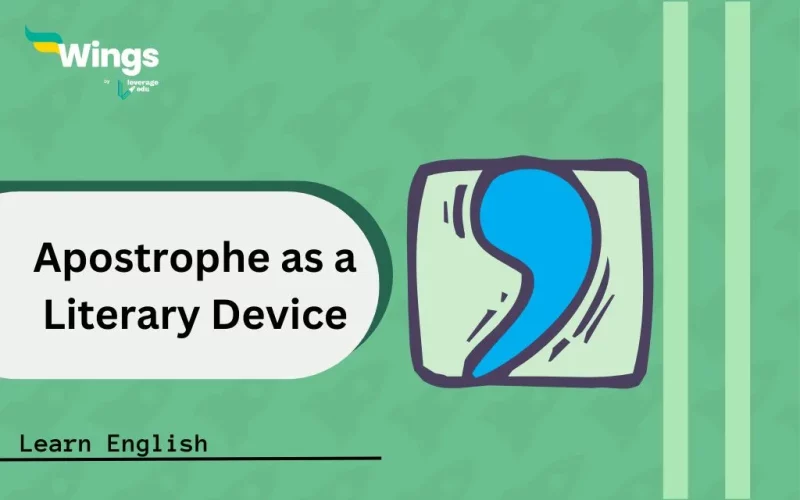When you hear of ‘apostrophe’, you probably think of the (‘) symbol right? Well, today we will be talking about how it can be used as a literary device. The apostrophe is a literary device that can be used to address or address a person who is not there or to personify an item, like Yorick’s skull in Hamlet. The name originates from the Greek verb apostrophes, meaning “to turn away.” To know more about Apostrophes as a literary device in English grammar, keep reading this blog.
This Blog Includes:
Explore: Punctuation: A Quick Guide: Types | Sample Exercise
What is an Apostrophe as a Literary Device?
An apostrophe is a literary device which writers use to address something or someone who is not physically present. This literary device is used in both everyday language and literary works. Lastly, it is a figure of speech that does not relate to the apostrophe as a punctuation mark.
However, this literary device is sometimes confused with the punctuation mark. In this case, an apostrophe acts as a contraction (eg: cannot = can’t) or shows possession (Shane’s cat).
Read More: Top 14 Punctuation Marks in English Grammar You Should Know
Why do we Use Apostrophes in Literature?
One must understand that literary apostrophes are a great way of conveying emotion in the text. They allow the speaker to offer a better view of their inner thoughts and feelings. Apostrophes were used a lot back in the 1900s, however, their usage has decreased over time. They can be seen in poems, plays, and songs. They can be easily found in everyday speech.
Format of Literary Apostrophe
There is no fixed format for a literary apostrophe. However, there are some common elements which need to be kept in mind while using.
- Direct Address: It is directly expressing someone or something that is not physically present. Example: “O Juliet, why art thou Juliet?”
- Figurative Language: Apostrophes often go hand-in-hand with other figures of speech to create a stronger effect. This could be personification (giving human qualities to something non-human) or metaphor/simile (comparing something to something else). Example: “The sea whispered secrets to the shore…”
- Emotional Tone: The use of apostrophes often creates a strong emotional tone, like grief, anger, or wonder. This can be achieved through word choice and sentence structure.
- No Punctuation Mark: Unlike the apostrophe used for contractions or possession (‘), the literary apostrophe doesn’t involve any punctuation mark.
Also Read: 21+ Apostrophe Examples in Sentences as Punctuation Mark
Literary Apostrophe: Functions and Examples
The function of an apostrophe depends upon who or what is being addressed in the sentence. Take a look at the following chart to understand all about literary apostrophes and how they can be used.
| Subject | Description | Function | Usage | Examples |
| Dead | Addressing someone who is no longer alive. | Shows the impact the person had on the speaker, which could be positive or negative. | Talking/ conversing with a dead loved one. | “Grandma I know you are in a better place.” |
| Absent | Someone alive but not physically present. | Allows the character to speak about the subject without reservation. | Questioning someone absent from the situation. | “Shane, where are you?” |
| Inanimate | Refers to an inanimate object which is typically personified. | Emphasizes the importance of the object to the speaker using human characteristics. | Addressing a stoplight | “Don’t worry Harry, I’ll open the parachute. You just hang on.” |
| Abstract | Relates to an abstraction such as an emotion, i.e. love, anger, hunger etc. | Lets the speaker grasp or present the abstraction in human terms that are easier to understand. | Speaking directly to a personified emotion | “Hello darkness, my old friend, how are you?” |
Exercise on Literary Apostrophe
Instruction: In the following excerpts, identify the use of apostrophe and explain who or what is being addressed.
- “O Death, where is thy sting? O grave, where is thy victory?”
- “Twinkle, twinkle, little star, how I wonder what you are!”
- “O Captain! My Captain! our fearful trip is done.”
- “Is this a dagger which I see before me, the handle toward my hand? Come, let me clutch thee.”
- “Roll on, thou deep and dark blue Ocean—roll!”
Answer’s
- Apostrophe Used: “O Death, where is thy sting? O grave, where is thy victory?”
- Apostrophe Used: “Twinkle, twinkle, little star, how I wonder what you are!”
- Apostrophe Used: “O Captain! My Captain! our fearful trip is done.”
- Apostrophe Used: “Is this a dagger which I see before me, the handle toward my hand? Come, let me clutch thee.”
- Apostrophe Used: “Roll on, thou deep and dark blue Ocean—roll!”
Read more blogs on Punctuation here:
FAQs
Ans: Here is an example of an apostrophe in literature: “O Romeo, Romeo, wherefore art thou Romeo?”
Ans: In literary works, apostrophes are used to draw the reader’s attention to anything other than the speaker.
Ans: Three functions of the apostrophe are as follows:
1) it forms possessive nouns;
2) it indicates letter omissions; and
3) it indicates plurals of letters, numbers, and symbols.
We hope this blog has provided you with all the necessary information on “apostrophes as a literary device.” To advance your grammar knowledge and read more informative blogs, check out our Learn English page and don’t forget to follow Leverage Edu.
 One app for all your study abroad needs
One app for all your study abroad needs














 45,000+ students realised their study abroad dream with us. Take the first step today.
45,000+ students realised their study abroad dream with us. Take the first step today.
